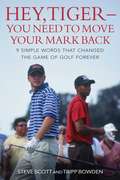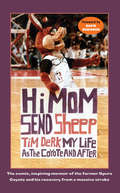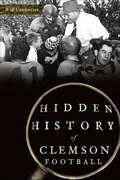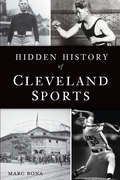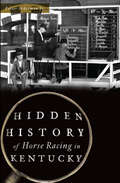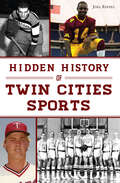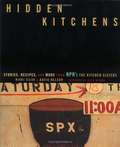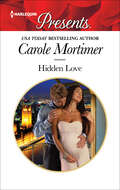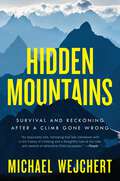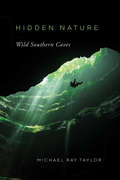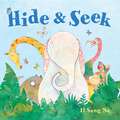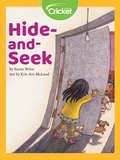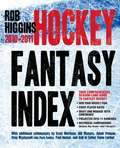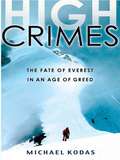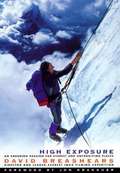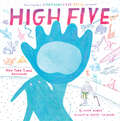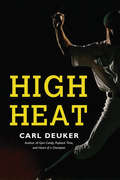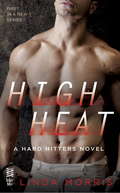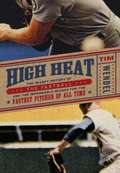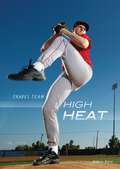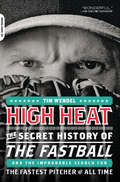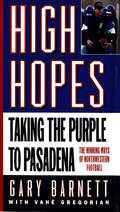- Table View
- List View
Hey, Tiger—You Need to Move Your Mark Back: 9 Simple Words that Changed the Game of Golf Forever
by Steve Scott Tripp BowdenExperience the thrill, twenty-five years later, of Steve Scott's epic finals match against Tiger Woods in the 1996 United States Amateur Championship! In August of &‘96, Steve Scott went head to head against Tiger Woods at Pumpkin Ridge Golf Club in the finals of the US Amateur Championship. Five thousand three hundred forty-five players whittled down to two. Scott found himself a surprising 5-up after the first 18, but at hole 35 Tiger squared the grueling match with an improbable 40-foot birdie putt. With the result coming down to the last hole, the difference in the outcome actually came earlier, when Scott reminded Woods to move his mark back to its rightful place on hole 34. Had Scott not done the morally correct thing, Tiger would have been penalized and, in turn, not have won three straight U.S. Amateur Championships (something not even the great Jack Nicklaus or legendary Bobby Jones had done), forever changing the course of Tiger&’s career and golf history.In Hey, Tiger—You Need to Move Your Mark Back, Scott teams up with esteemed storyteller Tripp Bowden to explain, twenty-five years later, what led to that life-changing moment and to describe, in his own words, the exhilaration of that &‘96 U. S. Amateur Championship and how it ultimately changed golf history and the two competitors' lives.Forever.Hey Tiger—You Need to Move Your Mark Back is a story for the ages for golf fans looking for an unlikely new perspective on the greatest game in the world.
Hi Mom, Send Sheep!
by David Robinson Tim DerkAt 47, Tim Derk had long been the San Antonio Spur's crowd-pleasing Coyote and was widely regarded as the NBA's funniest, most inventive mascot. Then, as the Spurs were headed toward their third championship, Derk suffered a massive stroke and his seemingly charmed existence was shattered. Here, he recounts his courageous battle to recover from the stroke's devastating impact, both on his body and his career. Amusing reminiscences of Spurs' players and owners, and of his own on-court hijinks, enliven Derk's uplifting tale of stroke survival.
Hi Mom, Send Sheep!
by David Robinson Tim DerkAt 47, Tim Derk had long been the San Antonio Spur's crowd-pleasing Coyote and was widely regarded as the NBA's funniest, most inventive mascot. Then, as the Spurs were headed toward their third championship, Derk suffered a massive stroke and his seemingly charmed existence was shattered. Here, he recounts his courageous battle to recover from the stroke's devastating impact, both on his body and his career. Amusing reminiscences of Spurs' players and owners, and of his own on-court hijinks, enliven Derk's uplifting tale of stroke survival.
Hidden History of Clemson Football (Sports)
by Will VandervortFrom its auspicious start in 1896 to being on top of the college football world under Dabo Swinney, Clemson Football is one of the more colorful programs in all of college football. Learn how the program got its start in 1896 with a donation of land. Discover the beginning of the IPTAY program. Find out the origin of the Tiger paw and the tradition of the Clemson two-dollar bill. And, of course, get the backstage look at the "good ol' fashioned hate" that makes the Clemson-Carolina rivalry such a passionate one. Author Will Vandervort provides a behind-the-scenes look at Clemson Football's small beginnings to its current elite status as a three-time national champion and college football power under Swinney.
Hidden History of Cleveland Sports (Sports)
by Marc BonaCleveland sports history goes well beyond The Shot, The Fumble, The Drive and so many other ignoble moments. Many of the city's most illustrious sports tales are long-forgotten chapters of tribulations and tragedy, of fleeting fame and enduring milestones. There are forgotten firsts, such as football's first pass and the invention of baseball's slider having ties to Cleveland. There are overshadowed tragedies like a fatal crash involving an Indians pitcher occurring the same year two of the team's hurlers were killed in a high-profile boating accident. And then there are the near misses--like George Steinbrenner coming within seconds of owning the Indians and a famous musician who almost became a Cleveland Brown. From basketball to boxing, hockey to Heisman, journalist Marc Bona chronicles more than a century of unremembered tales.
Hidden History of Horse Racing in Kentucky (Hidden History Ser.)
by Foster Ockerman Jr.A behind-the-scenes history of the Bluegrass State&’s iconic sport. Horse racing and the Commonwealth of Kentucky are synonymous. The equine industry in the state dates as far back as the eighteenth century, and some of that history remains untold. The Seventeenth Earl of Derby made the trip from England to Louisville for the famed Kentucky Derby. Many famous African American jockeys grew up in the area but fled to Europe during the Jim Crow era. Gambling on races is a popular pastime, but betting in the early days caused significant changes in the sport. Hidden History of Horse Racing in Kentucky details the rich and the lesser-known history at the tracks in the Bluegrass State.
Hidden History of Twin Cities Sports (Sports)
by Joel RippelTwin Cities sports fans are well-versed in disappointment, but the last 120 years of Minneapolis and St. Paul sports have also produced forgotten milestones. Most know of the Vikings' Super Bowl woes and the Twins' record-setting postseason losing streak. Few know that the first full-time college basketball coach originated here and that a Babe Ruth home run record supplanted a local player's achievement. Fewer still know about near misses like John Wooden almost becoming the University of Minnesota basketball coach in 1948 and Billie Jean King turning down an offer to join the Twin Cities' World Team Tennis franchise. Longtime Twin Cities journalist Joel Rippel documents these subjects and other forgotten or unheralded stories.
Hidden Kitchens: Stories, Recipes, and More from NPR's The Kitchen Sisters
by Davia Nelson Nikki Silva"The Kitchen Sisters off-beat kitchen stories make me want to walk through my neighborhood, go on a road trip and eat the food of family -- they have heart." Francis Ford Coppola. Hidden Kitchens, the popular and highly acclaimed radio series on NPR's Morning Edition, is the inspiration for a new book by the Peabody Award-winning producers, The Kitchen Sisters, Davia Nelson & Nikki Silva. Hidden Kitchens explores the world of street corner cooking, legendary meals, kitchen rituals, and visionaries - how communities come together through food. When the Hidden Kitchens project began, The Kitchen Sisters and co-producer Jay Allison, opened up a NPR Hotline and asked listeners, "What food traditions are disappearing from your life?" "Who glues your community together through food?" Hundreds of listeners called to share their stories, tips and rituals. Hidden Kitchens: Stories Recipes and More" interweaves stories and characters from the radio series, with phone messages from listeners and a wealth of new material from the enormous archive of interviews, photographs, and recipes gathered for the series. There are stories about a midnight cabyard kitchen on the streets of San Francisco, makeshift kitchens crammed in the racing pits of NASCAR, a secret civil rights kitchen tucked away in a house in Montgomery, and the most unexpected hidden kitchen of all, The George Foreman Grill. The reader gets a peek inside the world of secret, little known, private kitchens, where traditions are carried on and communities are tended and fed from the freighter galleys of the Great Lakes, to fire pits in Kentucky, to a fennel patch in San Francisco. Hidden Kitchens is a sometimes poignant, sometimes wild chronicle of American life and how family and community traditions are passed along through food.
Hidden Love
by Carole MortimerRe-read this classic romance by USA Today bestselling author CaroleMortimerCompletely infatuated with successful pro-tennis player Nick St. Clare, Rachel offersno resistance to his sinful seduction. But when their unbridled passion results in apregnancy, Nick insists that Rachel marry him—no heir of his will be without a father!Rachel knows their marriage is one of convenience, yet the incendiary heat between themstill burns bright! But with Nick off traveling the world, how can she convince herhusband that there's more to their marriage than just a baby? Originally published in 1982
Hidden Mountains: Survival and Reckoning After a Climb Gone Wrong
by Michael WejchertThe story of a climbing adventure gone wrong in a remote Alaskan mountain range, the impossible rescue attempt that followed, and the fraught cost of survivalIn 2018, two couples set out on an expedition to Alaska’s Hidden Mountains, one of the last wild ranges in North America. A rarity in modern climbing, the peaks were nearly unexplored and untouched, a place where few people had ever visited and granite spires still awaited first ascents. Inspired by generations of daring alpinists before them, the four friends were now compelled to strike out into uncharted territory themselves.This trip to the Hidden Mountains would be the culmination of years of climbing together, promising to test the foursome’s skill and dedication to the sport. But as they would soon discover, no amount of preparation can account for the unknowns of true wilderness. As they neared the top of an unclimbed peak, rockfall grievously injured one of the team while he was out of sight, leaving him stranded and in critical condition.Over the course of the next nine hours, the other three climbers worked to reach their companion. What followed was a pulse-pounding rescue attempt by Alaska’s elite pararescue jumpers in one of the most remote regions in the country—raising difficult questions about wilderness accessibility, technology’s role in outdoor adventure, and what it means to weigh risk against the siren song of the mountains.With visceral prose, Michael Wejchert recounts the group’s rescue and traces the scars left in the wake of life-altering trauma. Weaving the history and evolution of rock and alpine climbing with outside tales of loss and survival in the mountains, Wejchert gives a full picture of the reward—and cost—of following your passions in the outdoors.
Hidden Nature: Wild Southern Caves
by Michael Ray TaylorMore than ten thousand known caves lie beneath the state of Tennessee according to the Tennessee Cave Survey, a nonprofit organization that catalogs and maps them. Thousands more riddle surrounding states. In Hidden Nature, Michael Ray Taylor tells the story of this vast underground wilderness. In addition to describing the sheer physical majesty of the region&’s wild caverns and the concurrent joys and dangers of exploring them, he examines their rich natural history and scientific import, their relationship to clean water and a healthy surface environment, and their uncertain future. As a longtime caver and the author of three popular books related to caving—Cave Passages, Dark Life, and Caves—Taylor enjoys (for a journalist) unusual access to this secretive world. He is personally acquainted with many of the region&’s most accomplished cave explorers and scientists, and they in turn are familiar with his popular writing on caves in books; in magazines such as Audubon, Outside, and Sports Illustrated; and on websites such as those of the Discovery Channel and the PBS science series Nova.Hidden Nature is structured as a comprehensive work of well-researched fact that reads like a personal narrative of the author&’s long attraction to these caves and the people who dare enter their hidden chambers.
Hide & Seek
by Il Sung NaAs Elephant counts from one to ten, all the animals find special places to hide. When it's time to seek, will he be able to find everyone . . . even Chameleon?Like Na's previous books, Hide & Seek offers rich illustrations, bright colors, and a simple, spare text—all wrapped up in a beautiful kid-friendly package. Elephant counts from one to ten in big, bold numerals, and there's an additional butterfly on each spread, giving readers something to count as the story goes along. Kids will also love spotting the camouflaged chameleon on every page!
Hide-and-Seek
by Susan WeissLet's play a game of hide-and-seek. I'll hide first, and don't you peek!
Higgins Hockey Fantasy Index: 2010-2011
by Rob HigginsROCK YOUR FANTASY LEAGUEAttention, hockey fantasy managers! Do you know which players offer the best value? Which player is a Cherry Pick? And who's a Cherry Bomb? Are some players only Foxy by Proxy? Higgins Hockey Fantasy Index is a gold mine for stats freaks--the key to unlocking hidden value and avoiding pitfalls in any hockey fantasy league. With his unique HFI system, Rob Higgins gives you the tools to make brilliant picks on draft day--and run the rest of your fantasy season like a rock 'n' roll superstar.
High Crimes: The Fate of Everest in an Age of Greed
by Michael KodasHigh Crimes is journalist Michael Kodas's gripping account of life on top of the world--where man is every bit as deadly as Mother Nature. In the years following the publication of Into Thin Air, much has changed on Mount Everest. Among all the books documenting the glorious adventures in mountains around the world, none details how the recent infusion of wealthy climbers is drawing crime to the highest place on the planet. The change is caused both by a tremendous boom in traffic, and a new class of parasitic and predatory adventurer. It's likely that Jon Krakauer would not recognize the camps that he visited on Mount Everest almost a decade ago. This book takes readers on a harrowing tour of the criminal underworld on the slopes of the world's most majestic mountain. High Crimes describes two major expeditions: the tragic story of Nils Antezana, a climber who died on Everest after he was abandoned by his guide; as well as the author's own story of his participation in the Connecticut Everest Expedition, guided by George Dijmarescu and his wife and climbing partner, Lhakpa Sherpa. Dijmarescu, who at first seemed well-intentioned and charming, turned increasingly hostile to his own wife, as well as to the author and the other women on the team. By the end of the expedition, the three women could not travel unaccompanied in base camp due to the threat of violence. Those that tried to stand against the violence and theft found that the worst of the intimidation had followed them home to Connecticut. Beatings, thefts, drugs, prostitution, coercion, threats, and abandonment on the highest slopes of Everest and other mountains have become the rule rather than the exception. Kodas describes many such experiences, and explores the larger issues these stories raise with thriller-like intensity.
High Exposure: An Enduring Passion for Everest and Unforgiving Places
by Jon Krakauer David F. BreashearsFor generations of resolute adventurers, from George Mallory to Sir Edmund Hillary, Tenzing Norgay to Jon Krakauer, Mount Everest and the world's greatest peaks have provided the ultimate testing ground. As the world's fascination with mountaineering reaches a fever pitch, the question remains: Why climb? In High Exposure, elite mountaineer and acclaimed filmmaker David Breashears answers with an intimate and captivating look at his life. Breashears's passion for climbing began on the cliffs of Boulder, Colorado--and nearly ended on the south side of Everest in 1996.
High Five
by Adam RubinA #1 New York Times bestseller from the creators of the beloved Dragons Love Tacos comes a rollicking, rhyme-tastic, interactive high five competition--starring YOU!Discover the lost art of the high five and improve your slapping skills just in time for the annual high five contest! From hand-limbering stretches to lessons on five-ing with finesse, readers are guided through a series of interactive challenges, each goofier than the next.Acclaimed creative duo Adam Rubin and Daniel Salmieri have dreamed up another one-of-a-kind, laugh-out-loud book that kids will beg to read again and again.
High Heat
by Carl DeukerLike the game of baseball, life is quirky and unpredictable, as Shane Hunter discovers in the spring of his sophomore year. Suddenly and without warning his life of privilege is turned upside down. And just as suddenly, life begins to seem utterly without fairness or purpose to him.Exciting, well-written sports scenes transport readers right into the stands while complex issues engage their hearts and minds. For here is a novel of loss, of morality, and of the rare, redemptive power of baseball. Can speaking the truth really determine lives? Just how does one accept, move on, and begin doing the right thing?
High Heat
by Linda MorrisThe author of Melting the Millionaire's Heart gives readers a front-row seat to her new Hard Hitters baseball series. First up at bat: a hotshot pitcher and a PR pro battle it out on and off the field...Small-town Indiana tomboy Sarah Dudley grew up living and breathing baseball, since her father owned the minor league Plainview Thrashers. A talented player herself, she idolized her brother's best friend: Tom Cord, a pitcher with a wicked fastball and an even more wicked reputation.Now, Sarah is the Thrashers' VP of public relations, and Tom--a star in the major leagues--has been assigned to the club while rehabbing from surgery. It's Sarah's job to keep the hard-throwing, hard-living star out of trouble. But when she gets a glimpse of the man behind the bad-boy image, they start to generate more heat than an inside fastball...Includes a preview of the next Hard Hitters novel, Screwball"Readers will cheer for Tom and Sarah!"-- Jeannette Murray, author of One Night with a QuarterbackPraise for Linda Morris: "Linda Morris has a delightful writing voice and I can't wait to read more stories from her!"--Ex Libris "Fun, sexy, heartbreaking at times, and left a smile on my face!"--Book Loving Me
High Heat
by Tim WendelWhat is it about a quality fastball that brings us to the edge of our seats? How is it humanly possible to throw more than 100 mph? And the big question: Who is the fastest pitcher ever? Drawing on interviews with current and former players, managers, scouts, experts, and historians, Tim Wendel delivers the answers to some of the most intriguing questions about the fastball, providing insight into one of baseball's most exhilarating yet mystifying draws. In High Heat he takes us on a quest to separate verifiable fact from baseball lore, traveling from ballparks across the country to the Baseball Hall of Fame, piecing together the fascinating history of the fastball from its early development to the present form while exploring its remarkable impact on the game and the pitchers who have been blessed (or cursed) with its gift. From legends such as Nolan Ryan, Walter Johnson, Steve Dalkowski, and Satchel Paige to present-day standard bearers like Tim Lincecum, Billy Wagner, and Randy Johnson, Wendel examines the factors that make throwing heat an elusive ability that few have and even fewer can harness. Along the way he investigates the effectiveness of early speed-testing techniques (including Bob Feller's infamous motorcycle test), explains why today's radar gun readings still leave plenty of room for debate, and even visits an aerodynamic testing lab outside of Birmingham, Alabama, in order to understand the mechanics that make throwing heat possible in the first place. At its heart, High Heat is a reflection on our infatuation with the fastball--the expectation it carries, the raw ability it puts on display, and, most of all, the feats and trials of those who have attempted to master it. As Wendel puts it, "The tale of high heat can lead in several different directions at once, and the real story has more to do with triumph and tragedy that with the simple act of throwing a baseball."
High Heat
by Tim WendelAn irresistible journey to the heart of baseball and our infatuation with one of the game s most fascinating and elusive draws"
High Heat (Travel Team)
by Andrew KarrePitcher Seth Carter had Tommy John surgery on his elbow in hopes of being able to throw harder. Now his fastball cuts through batters like a 90-mph knife through butter. But one day, Seth's pitch gets away from him. The clunk of the ball on the batter's skull still haunts Seth in his sleep and on the field. His arm doesn't feel like part of his body anymore, and he goes from being the ace everybody wanted to the pitcher nobody trusts. With the biggest game of the year on the line, can Seth come through for the team?
High Heat: The Secret History of the Fastball and the Improbable Search for the Fastest Pitcher of All Time
by Tim WendelWhat is it about a quality fastball that brings us to the edge of our seats? How is it humanly possible to throw more than 100 mph? And the big question: Who is the fastest pitcher ever? Drawing on interviews with current and former players, managers, scouts, experts, and historians, Tim Wendel delivers the answers to some of the most intriguing questions about the fastball, providing insight into one of baseball’s most exhilarating yet mystifying draws. In High Heat he takes us on a quest to separate verifiable fact from baseball lore, traveling from ballparks across the country to the Baseball Hall of Fame, piecing together the fascinating history of the fastball from its early development to the present form while exploring its remarkable impact on the game and the pitchers who have been blessed (or cursed) with its gift. From legends such as Nolan Ryan, Walter Johnson, Steve Dalkowski, and Satchel Paige to present-day standard bearers like Tim Lincecum, Billy Wagner, and Randy Johnson, Wendel examines the factors that make throwing heat an elusive ability that few have and even fewer can harness. Along the way he investigates the effectiveness of early speed-testing techniques (including Bob Feller’s infamous motorcycle test), explains why today’s radar gun readings still leave plenty of room for debate, and even visits an aerodynamic testing lab outside of Birmingham, Alabama, in order to understand the mechanics that make throwing heat possible in the first place. At its heart, High Heat is a reflection on our infatuation with the fastball-the expectation it carries, the raw ability it puts on display, and, most of all, the feats and trials of those who have attempted to master it. As Wendel puts it, “The tale of high heat can lead in several different directions at once, and the real story has more to do with triumph and tragedy that with the simple act of throwing a baseball. ”
High Hopes: Taking the Purple to Pasadena
by Gary Barnett Vahé GregorianThis is the inspiring story of how, against all odds, football coach Gary Barnett took on a losing tradition & led the Northwestern Univ. Wildcats to the Rose Bowl. In a candid account of the 1995 season, he takes you into the locker room, onto the sidelines, & out onto the playing field as the perpetual underdog Wildcats stunned their opponents, amazed the world, & slowly convinced themselves that they could play & beat the best. Revealing the endlessly creative motivational techniques he used, Barnett looks back at his team's surge as a highly disciplined playing unit. Delves into what it means to strive, to fear, to pick yourself up, & to bring winning into your heart & your life.
